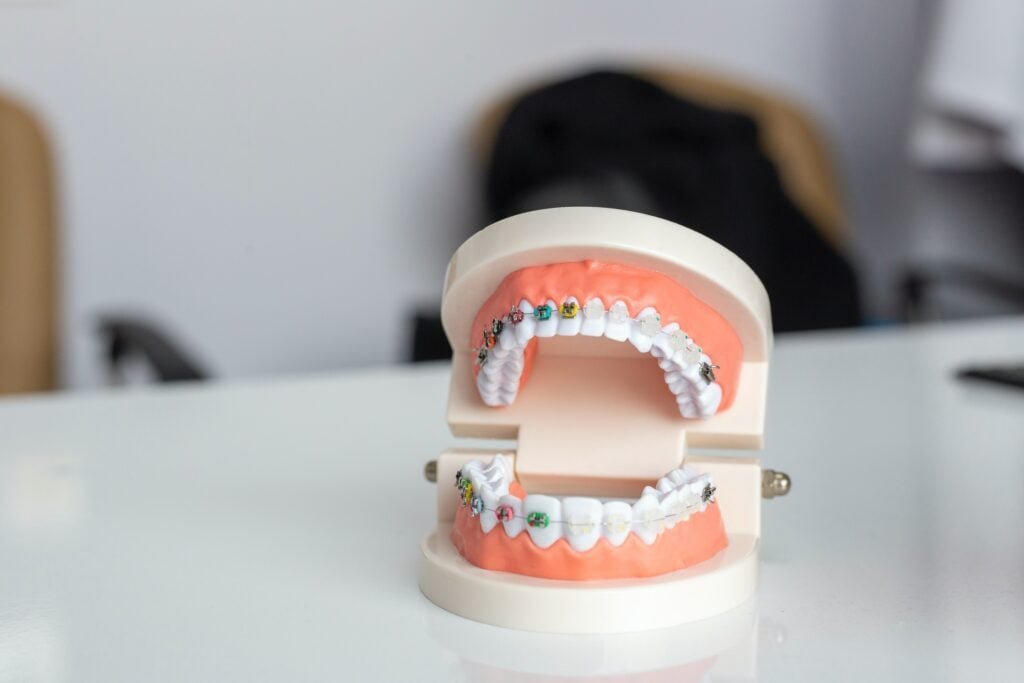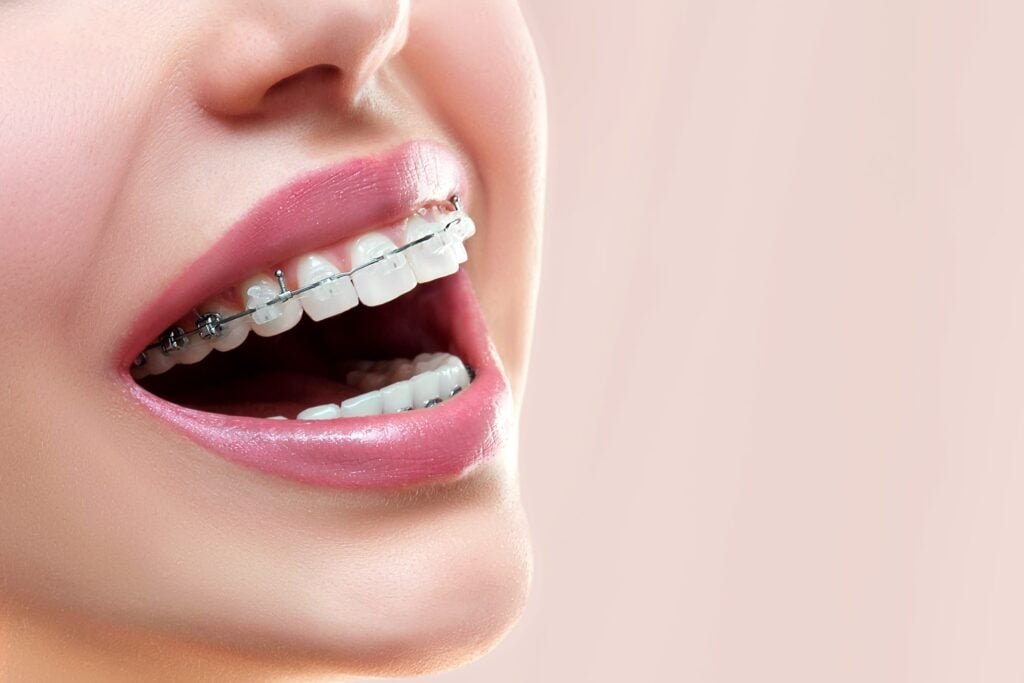Ceramic Braces (Pros, Cons & Costs)

What are Ceramic Braces?
Ceramic braces are similar to traditional metal braces, except they have clear or tooth-colored brackets. They’re orthodontic appliances designed to straighten teeth and close gaps.

Some people choose ceramic braces because they’re less noticeable than metal braces. The brackets, glued to the front surfaces of your teeth, consist of a material designed to blend in with your smile. An archwire connects the brackets and controls tooth movement.
Ceramic braces are suitable for people who have all of their adult teeth. They allow for quick correction and a smaller chance of the brackets breaking from the strain of tooth movement.
How Much Do Ceramic Braces Cost?
Ceramic braces are more expensive than traditional metal braces, with an average cost of $4,000 to $8,000.2
Dental insurance may or may not cover the cost of ceramic braces. Your plan must include orthodontic coverage to qualify for full or partial coverage. The braces must also be medically necessary and not a purely cosmetic treatment.
While ceramic braces can be expensive, many people don’t mind paying a premium for their improved esthetics over metal braces.
Ceramic Braces vs. Traditional Metal Braces
The main difference between ceramic braces and traditional metal braces is their appearance. However, there are other distinctions you should know when deciding between the two.
Ceramic braces differ from traditional metal braces in a few ways:
Visibility or Esthetics
You might prefer ceramic braces over metal braces because they’re less noticeable. For some people, ceramic braces help them feel less self-conscious about straightening their teeth.
Comfort
Ceramic braces may be more comfortable than metal ones because they consist of materials that are less likely to irritate your gums or the sides of your mouth. Oral irritation is a common complaint with metal braces.
When your orthodontist places your ceramic braces, you may feel some pain or discomfort. However, this should subside after 2 to 4 weeks.
Treatment Length
Ceramic braces take between 1 and 3 years to straighten teeth. Metal braces often take less time.
Ceramic options also aren’t as durable. As your teeth move, the brackets may need to be replaced more often to stop them from cracking under pressure. This results in a longer treatment time.
If ceramic braces break, treatment might take longer.
Costs and Insurance
On average, ceramic braces cost around $4,000 to $8,000.2 Comparatively, metal braces cost around $3,000 to $6,000.
Both ceramic and metal braces only qualify for insurance coverage if your dental insurance includes orthodontic coverage. You’ll need to check the details of your specific plan or invest in a new one.
If you’re getting braces for cosmetic reasons, insurance won’t typically cover it. However, you may be able to use a payment plan or other financing options that your dentist provides.
Pros and Cons of Ceramic Braces
If you’re considering ceramic braces as an option, it’s crucial to understand their advantages and disadvantages.
Pros of Ceramic Braces
The advantages of ceramic braces include:
- Their subtle look — Ceramic braces are less visible than traditional braces. The material is either clear, tooth-colored, or white.
- They’re more effective than some alternatives — Ceramic braces treat various conditions. Other esthetic-forward options like clear aligners may not treat more severe problems.
- They don’t interfere with imaging tests — Metal braces can affect signals in imaging tests. Ceramic options produce much less signal interference.1
- You’re less likely to be allergic to them — An allergy to nickel in orthodontic appliances like metal braces is the most common allergic reaction in dental practices. Ceramic braces are much less likely to cause an allergic reaction.
Cons of Ceramic Braces
The cons of ceramic braces include:
- They’re more expensive — Ceramic braces cost at least $1,000 to $2,000 more than traditional metal braces.
- Cleaning them is harder — Ceramic brackets are larger than metal ones, making oral hygiene more difficult. This can lead to oral health problems such as cavities and gum disease.
- They might break — Ceramic braces are less durable than metal ones. They’re more than twice as likely to break or fracture, especially on the lower teeth.
- Changes happen slower — Ceramic braces move teeth slower than metal ones. If they break, repairs can delay the straightening process.
- They often stain — The elastic o-ties connecting the wire and brackets can stain easily.
- They’re harder to remove — Removing ceramic braces requires more force than metal options. During removal, the fracturing of ceramic braces may make parts stick on the teeth.
- Demineralization of enamel — Compared to metal braces, ceramic is more likely to decrease mineral content in tooth enamel.
Watch our Podcast
Ceramic Braces: Cost, Pros, Cons, and Alternatives
NewMouth Podcast
Are Ceramic Braces Right For You? 3 Alternative Treatments
Ceramic braces can be an excellent choice if you’re looking for a subtle way to straighten your teeth. However, they often cost more than other options and stain more easily.
Speak with your dentist or orthodontist before you choose ceramic braces. Another treatment might be more effective for your teeth, even if it’s not your first choice.
Here are some popular alternative options:
Metal Braces
Traditional braces consist of metal brackets that are fixed to your teeth and connected by wire. They are the most common treatment for:
- Crooked and crowded teeth
- Jaw problems
- Misaligned bites
They can help treat problems with eating, speaking, or keeping your teeth clean.
Technological advancements have made metal braces sleeker, smaller, and more comfortable than ever. They’re also more affordable but less attractive than ceramic braces.
Clear Aligners
Aligners are another subtle option for improving your smile. They straighten misaligned teeth and fix overbites, overjets, crossbites, gaps, and overcrowding. They cannot be used to treat more severe issues. The trays are clear and almost invisible.
Clear aligners are removable orthodontic devices. This makes them more comfortable than traditional metal and ceramic braces. Although convenient, tooth movement is less precise than traditional braces.
Lingual Braces
Lingual braces are similar to traditional braces that use wires and brackets. However, they’re placed on the back of teeth, making them nearly invisible.
Many adults prefer lingual braces because of their subtlety. Remember, though, that lingual braces are more difficult to clean and may be more uncomfortable because of their position. They also aren’t suitable for people with an excessive overbite.
Summary
Ceramic braces are a less noticeable alternative to traditional metal braces. They’re an orthodontic appliance that straightens teeth and corrects bad bites. Many people opt for ceramic braces because the brackets more closely match the color of their teeth.
Compared to metal braces, ceramic braces are more expensive, at a cost of around $4,000 to $8,000. If they’re a medically necessary treatment, you may be able to get them covered by insurance. However, your dental insurance must include orthodontic coverage to apply.
Alternative treatments to ceramic braces include traditional braces, clear aligners, and lingual braces. Always speak with your dentist to determine the right treatment for you.